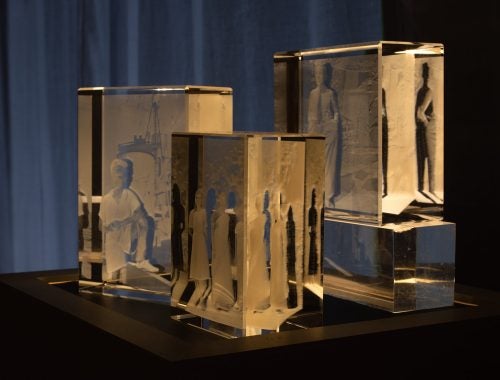Professor
Photography
written by HUGH MARKEY
Annu Palakunnathu Matthew discovered the story of the 2.5 million Indians who fought in World War II (WWII) while researching the Partition of British India.
“It’s a complicated history,” says the University of Rhode Island photography professor. “As a result, these soldiers are not recognized in South Asia or globally.”
Matthew notes, that even as the war raged, India was fighting for independence from the British Empire. By siding with the Allied powers, the Indian soldiers were seen by some as supporting British colonialism.

For Matthew, her artwork asks if these soldiers’ personal contributions can be acknowledged – that sense of injustice drives much of her art.
“Few wanted to recognize the efforts of these Indian soldiers, but on the other hand, what would have happened if they hadn’t fought?” Matthew asks. “They were critical to the Allies success of WWII. Through my work, I’m asking whether they can be remembered, both in South Asia and globally, without negating the other historical players.”
Her research led to a commission from the Kochi-Muziris Biennale, the largest art exhibition in Asia. The installation and other works with the same theme were recently on display in Rhode Island’s Newport Art Museum.
“People will rarely take out a history book and read it. I think art can be a way to make history more accessible.”
–Annu Palakunnathu Matthew
“For this commission, I projected edited archival footage of the Indian soldiers who fought in the Italian Campaign onto the Indian gravestones and memorials in Italy’s Cassino and Forlì War Cemeteries at dawn and dusk,” Matthew explains. “I then edited these recordings to create a haunting video installation.”
Growing up in England, India, and the United States gave Matthew a unique perspective on these cultures.
“My work is shaped by my transcultural experience that contends with alienation and multiple cultural histories,” she says. “Because of these dualities of identities, my work is inspired by the experience of belonging and yet not belonging. This experience influenced my approach to teasing out links to voices of other alienated communities and histories in the U.S. and South Asia. Where colonial histories have long complicated things.”
Matthew says that the visual arts can play a role in changing perspectives and expanding one’s knowledge of history.
“People will rarely take out a history book and read it. I think art can be a way to make history more accessible.”
“We are at a moment where memorials and histories are being re-evaluated and reconsidered in significant ways. Art can play a crucial role in shaping remembrance. By pulling back the veil on forgotten histories, my objective is to leverage visual media to elevate this narrative and integrate it into our shared historical and cultural legacy.”
–Annu Palakunnathu Matthew
For her Newport show, Matthew created several crystal cubes etched with photographs. On a recent sabbatical and Fulbright Fellowship to India she collected these photos and stories from the South Asian families whose relatives served in WWII. One crystal features a man in the clothes of a military officer. He stares off camera and into the distance. Meanwhile, his wife directs her gaze into the camera and eyes of the viewer. The cubes are lit from below, giving the images
a ghostly appearance. Matthew says this display drew the most attention in her Newport show.
“I think there is a mysterious quality to the crystal images,” she says, reflecting on the reaction. “The immersive installation also includes audio that allows the viewer to connect with the personal stories and empathize with them.”
Matthew sees her work as another way of awakening people to a breadth of global histories that may otherwise be lost.
“I think there is a mysterious quality to the crystal images.”
–Annu Palakunnathu Matthew
“We are at a moment where memorials and histories are being re-evaluated and reconsidered in significant ways,” she says. “Art can play a crucial role in shaping remembrance. By pulling back the veil on forgotten histories, my objective is to leverage visual media to elevate this narrative and integrate it into our shared historical and cultural legacy.”
